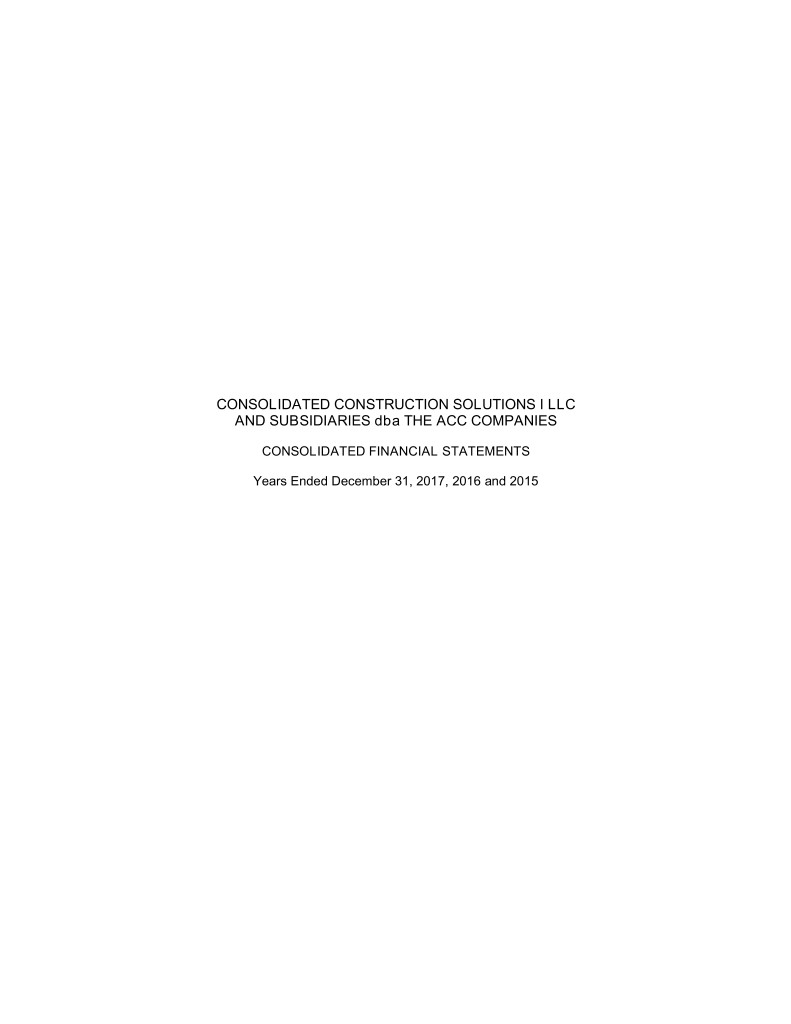
CONSOLIDATED CONSTRUCTION SOLUTIONS I LLC AND SUBSIDIARIES dba THE ACC COMPANIES CONSOLIDATED FINANCIAL STATEMENTS Years Ended December 31, 2017, 2016 and 2015
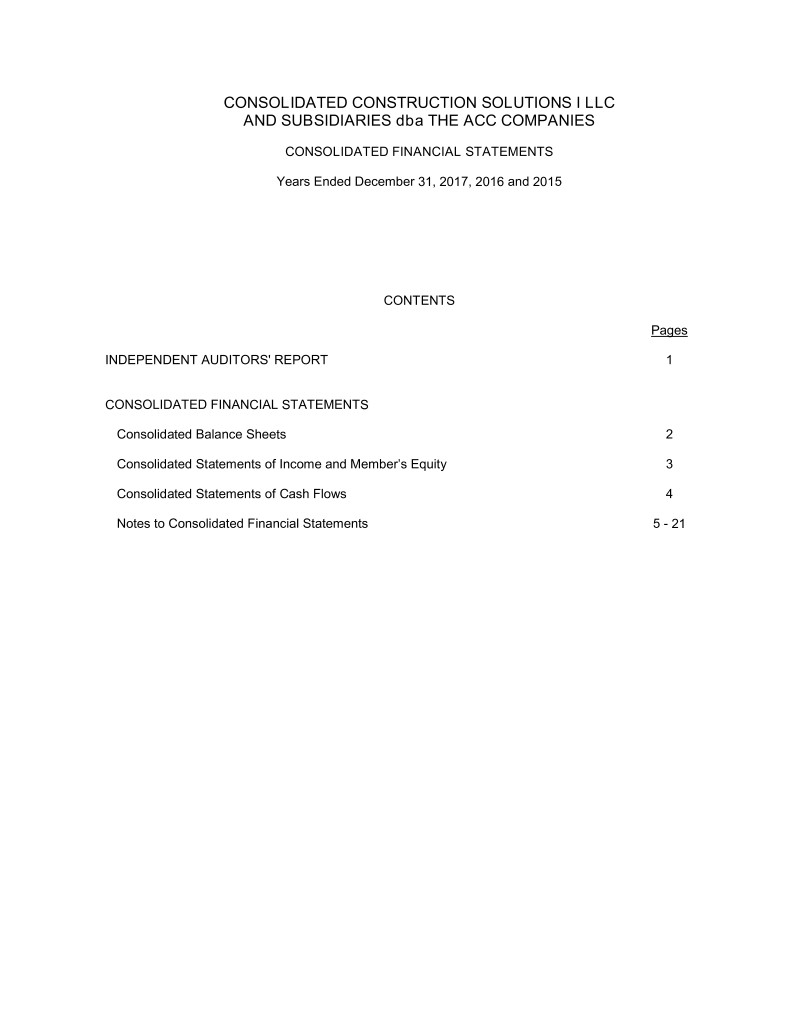
CONSOLIDATED CONSTRUCTION SOLUTIONS I LLC AND SUBSIDIARIES dba THE ACC COMPANIES CONSOLIDATED FINANCIAL STATEMENTS Years Ended December 31, 2017, 2016 and 2015 CONTENTS Pages INDEPENDENT AUDITORS' REPORT 1 CONSOLIDATED FINANCIAL STATEMENTS Consolidated Balance Sheets 2 Consolidated Statements of Income and Member’s Equity 3 Consolidated Statements of Cash Flows 4 Notes to Consolidated Financial Statements 5 - 21

4722 North 24th Street, Suite 300 ■ Phoenix, AZ 85016 Main: 602.264.6835 ■ Fax: 602.265.7631 ■ www.mhmcpa.com INDEPENDENT AUDITORS’ REPORT To the Sole Member of CONSOLIDATED CONSTRUCTION SOLUTIONS I LLC AND SUBSIDIARIES dba THE ACC COMPANIES We have audited the accompanying consolidated financial statements of Consolidated Construction Solutions I LLC and Subsidiaries dba The ACC Companies, which comprise the consolidated balance sheets as of December 31, 2017, 2016 and 2015, and the related consolidated statements of income and member’s equity, and cash flows for the years then ended, and the related notes to the consolidated financial statements. Management’s Responsibility for the Consolidated Financial Statements Management is responsible for the preparation and fair presentation of these consolidated financial statements in accordance with accounting principles generally accepted in the United States of America; this includes the design, implementation, and maintenance of internal control relevant to the preparation and fair presentation of consolidated financial statements that are free from material misstatement, whether due to fraud or error. Auditors’ Responsibility Our responsibility is to express an opinion on these consolidated financial statements based on our audits. We conducted our audits in accordance with auditing standards generally accepted in the United States of America. Those standards require that we plan and perform the audit to obtain reasonable assurance about whether the consolidated financial statements are free from material misstatement. An audit involves performing procedures to obtain audit evidence about the amounts and disclosures in the consolidated financial statements. The procedures selected depend on the auditor’s judgment, including the assessment of the risks of material misstatement of the consolidated financial statements, whether due to fraud or error. In making those risk assessments, the auditor considers internal control relevant to the entity’s preparation and fair presentation of the consolidated financial statements in order to design audit procedures that are appropriate in the circumstances, but not for the purpose of expressing an opinion on the effectiveness of the entity’s internal control. Accordingly, we express no such opinion. An audit also includes evaluating the appropriateness of accounting policies used and the reasonableness of significant accounting estimates made by management, as well as evaluating the overall presentation of the consolidated financial statements. We believe that the audit evidence we have obtained is sufficient and appropriate to provide a basis for our audit opinion. Opinion In our opinion, the consolidated financial statements referred to above present fairly, in all material respects, the financial position of Consolidated Construction Solutions I LLC and Subsidiaries dba The ACC Companies as of December 31, 2017, 2016 and 2015, and the results of their operations and their cash flows for the years then ended in accordance with accounting principles generally accepted in the United States of America. Change in Accounting Principle As discussed in Note 1 to the consolidated financial statements, during 2017 the Company adopted the amendments provided in Accounting Standards Update No. 2015-17, Income Taxes. Our opinion is not modified with respect to that matter. September 20, 2018 Member of Kreston International — a global network of independent accounting firms
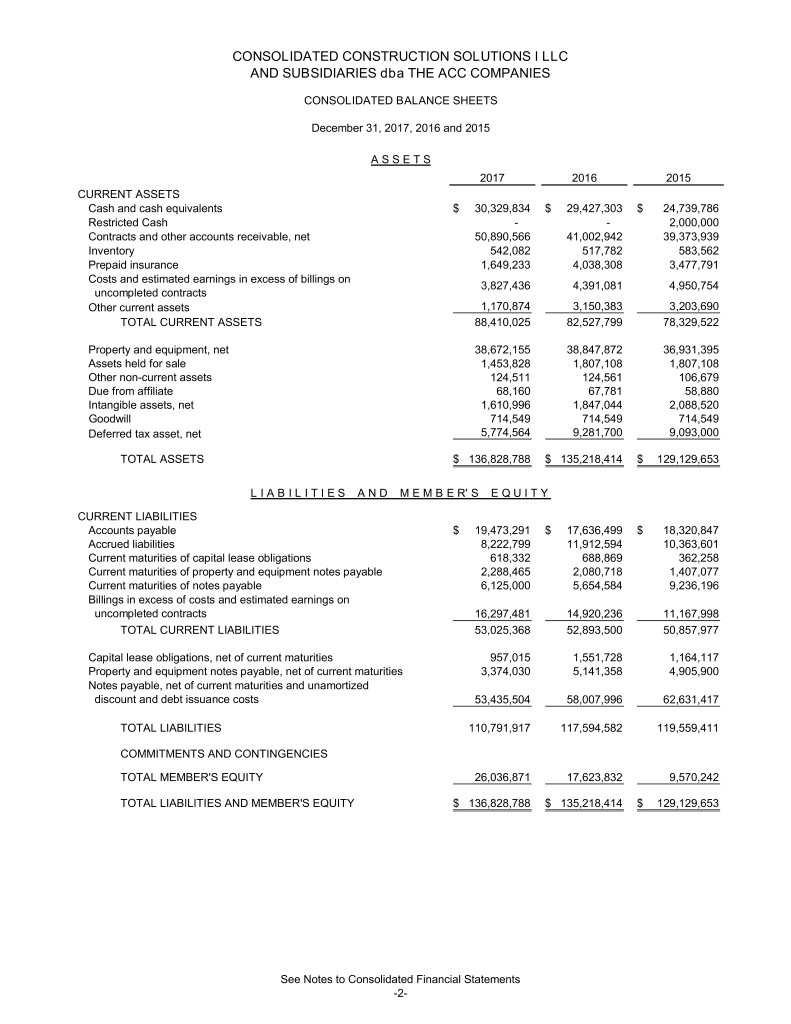
CONSOLIDATED CONSTRUCTION SOLUTIONS I LLC AND SUBSIDIARIES dba THE ACC COMPANIES CONSOLIDATED BALANCE SHEETS December 31, 2017, 2016 and 2015 A S S E T S 2017 2016 2015 CURRENT ASSETS Cash and cash equivalents $ 30,329,834 $ 29,427,303 $ 24,739,786 Restricted Cash - - 2,000,000 Contracts and other accounts receivable, net 50,890,566 41,002,942 39,373,939 Inventory 542,082 517,782 583,562 Prepaid insurance 1,649,233 4,038,308 3,477,791 Costs and estimated earnings in excess of billings on 3,827,436 4,391,081 4,950,754 uncompleted contracts Other current assets 1,170,874 3,150,383 3,203,690 TOTAL CURRENT ASSETS 88,410,025 82,527,799 78,329,522 Property and equipment, net 38,672,155 38,847,872 36,931,395 Assets held for sale 1,453,828 1,807,108 1,807,108 Other non-current assets 124,511 124,561 106,679 Due from affiliate 68,160 67,781 58,880 Intangible assets, net 1,610,996 1,847,044 2,088,520 Goodwill 714,549 714,549 714,549 Deferred tax asset, net 5,774,564 9,281,700 9,093,000 TOTAL ASSETS $ 136,828,788 $ 135,218,414 $ 129,129,653 L I A B I L I T I E S A N D M E M B E R' S E Q U I T Y CURRENT LIABILITIES Accounts payable $ 19,473,291 $ 17,636,499 $ 18,320,847 Accrued liabilities 8,222,799 11,912,594 10,363,601 Current maturities of capital lease obligations 618,332 688,869 362,258 Current maturities of property and equipment notes payable 2,288,465 2,080,718 1,407,077 Current maturities of notes payable 6,125,000 5,654,584 9,236,196 Billings in excess of costs and estimated earnings on uncompleted contracts 16,297,481 14,920,236 11,167,998 TOTAL CURRENT LIABILITIES 53,025,368 52,893,500 50,857,977 Capital lease obligations, net of current maturities 957,015 1,551,728 1,164,117 Property and equipment notes payable, net of current maturities 3,374,030 5,141,358 4,905,900 Notes payable, net of current maturities and unamortized discount and debt issuance costs 53,435,504 58,007,996 62,631,417 TOTAL LIABILITIES 110,791,917 117,594,582 119,559,411 COMMITMENTS AND CONTINGENCIES TOTAL MEMBER'S EQUITY 26,036,871 17,623,832 9,570,242 TOTAL LIABILITIES AND MEMBER'S EQUITY $ 136,828,788 $ 135,218,414 $ 129,129,653 See Notes to Consolidated Financial Statements -2-
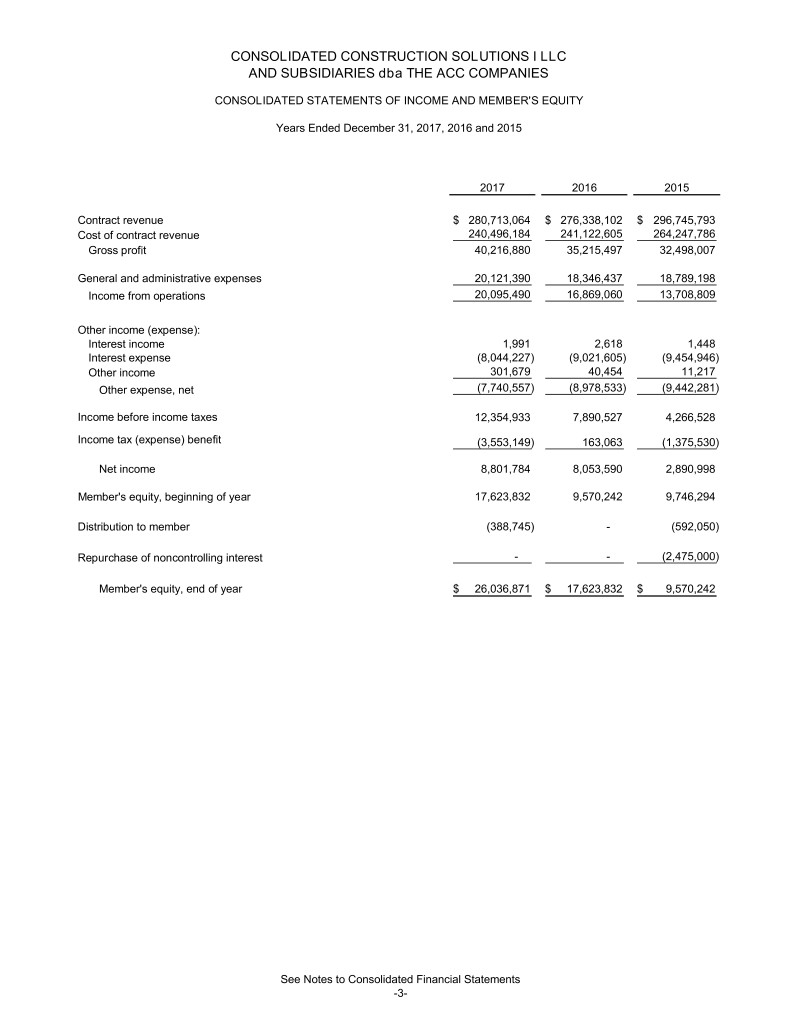
CONSOLIDATED CONSTRUCTION SOLUTIONS I LLC AND SUBSIDIARIES dba THE ACC COMPANIES CONSOLIDATED STATEMENTS OF INCOME AND MEMBER'S EQUITY Years Ended December 31, 2017, 2016 and 2015 2017 2016 2015 Contract revenue $ 280,713,064 $ 276,338,102 $ 296,745,793 Cost of contract revenue 240,496,184 241,122,605 264,247,786 Gross profit 40,216,880 35,215,497 32,498,007 General and administrative expenses 20,121,390 18,346,437 18,789,198 Income from operations 20,095,490 16,869,060 13,708,809 Other income (expense): Interest income 1,991 2,618 1,448 Interest expense (8,044,227) (9,021,605) (9,454,946) Other income 301,679 40,454 11,217 Other expense, net (7,740,557) (8,978,533) (9,442,281) Income before income taxes 12,354,933 7,890,527 4,266,528 Income tax (expense) benefit (3,553,149) 163,063 (1,375,530) Net income 8,801,784 8,053,590 2,890,998 Member's equity, beginning of year 17,623,832 9,570,242 9,746,294 Distribution to member (388,745) - (592,050) Repurchase of noncontrolling interest - - (2,475,000) Member's equity, end of year $ 26,036,871 $ 17,623,832 $ 9,570,242 See Notes to Consolidated Financial Statements -3-
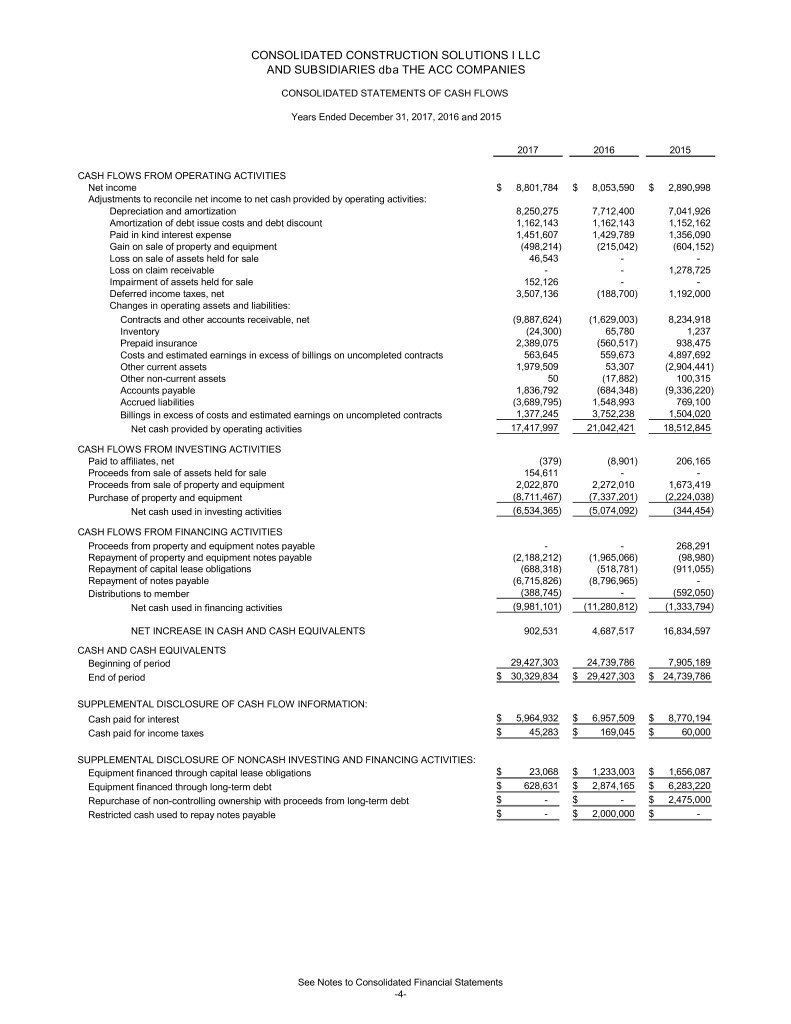
CONSOLIDATED CONSTRUCTION SOLUTIONS I LLC AND SUBSIDIARIES dba THE ACC COMPANIES CONSOLIDATED STATEMENTS OF CASH FLOWS Years Ended December 31, 2017, 2016 and 2015 2017 2016 2015 CASH FLOWS FROM OPERATING ACTIVITIES Net income $ 8,801,784 $ 8,053,590 $ 2,890,998 Adjustments to reconcile net income to net cash provided by operating activities: Depreciation and amortization 8,250,275 7,712,400 7,041,926 Amortization of debt issue costs and debt discount 1,162,143 1,162,143 1,152,162 Paid in kind interest expense 1,451,607 1,429,789 1,356,090 Gain on sale of property and equipment (498,214) (215,042) (604,152) Loss on sale of assets held for sale 46,543 - - Loss on claim receivable - - 1,278,725 Impairment of assets held for sale 152,126 - - Deferred income taxes, net 3,507,136 (188,700) 1,192,000 Changes in operating assets and liabilities: Contracts and other accounts receivable, net (9,887,624) (1,629,003) 8,234,918 Inventory (24,300) 65,780 1,237 Prepaid insurance 2,389,075 (560,517) 938,475 Costs and estimated earnings in excess of billings on uncompleted contracts 563,645 559,673 4,897,692 Other current assets 1,979,509 53,307 (2,904,441) Other non-current assets 50 (17,882) 100,315 Accounts payable 1,836,792 (684,348) (9,336,220) Accrued liabilities (3,689,795) 1,548,993 769,100 Billings in excess of costs and estimated earnings on uncompleted contracts 1,377,245 3,752,238 1,504,020 Net cash provided by operating activities 17,417,997 21,042,421 18,512,845 CASH FLOWS FROM INVESTING ACTIVITIES Paid to affiliates, net (379) (8,901) 206,165 Proceeds from sale of assets held for sale 154,611 - - Proceeds from sale of property and equipment 2,022,870 2,272,010 1,673,419 Purchase of property and equipment (8,711,467) (7,337,201) (2,224,038) Net cash used in investing activities (6,534,365) (5,074,092) (344,454) CASH FLOWS FROM FINANCING ACTIVITIES Proceeds from property and equipment notes payable - - 268,291 Repayment of property and equipment notes payable (2,188,212) (1,965,066) (98,980) Repayment of capital lease obligations (688,318) (518,781) (911,055) Repayment of notes payable (6,715,826) (8,796,965) - Distributions to member (388,745) - (592,050) Net cash used in financing activities (9,981,101) (11,280,812) (1,333,794) NET INCREASE IN CASH AND CASH EQUIVALENTS 902,531 4,687,517 16,834,597 CASH AND CASH EQUIVALENTS Beginning of period 29,427,303 24,739,786 7,905,189 End of period $ 30,329,834 $ 29,427,303 $ 24,739,786 SUPPLEMENTAL DISCLOSURE OF CASH FLOW INFORMATION: Cash paid for interest $ 5,964,932 $ 6,957,509 $ 8,770,194 Cash paid for income taxes $ 45,283 $ 169,045 $ 60,000 SUPPLEMENTAL DISCLOSURE OF NONCASH INVESTING AND FINANCING ACTIVITIES: Equipment financed through capital lease obligations $ 23,068 $ 1,233,003 $ 1,656,087 Equipment financed through long-term debt $ 628,631 $ 2,874,165 $ 6,283,220 Repurchase of non-controlling ownership with proceeds from long-term debt $ - $ - $ 2,475,000 Restricted cash used to repay notes payable $ - $ 2,000,000 $ - See Notes to Consolidated Financial Statements -4-
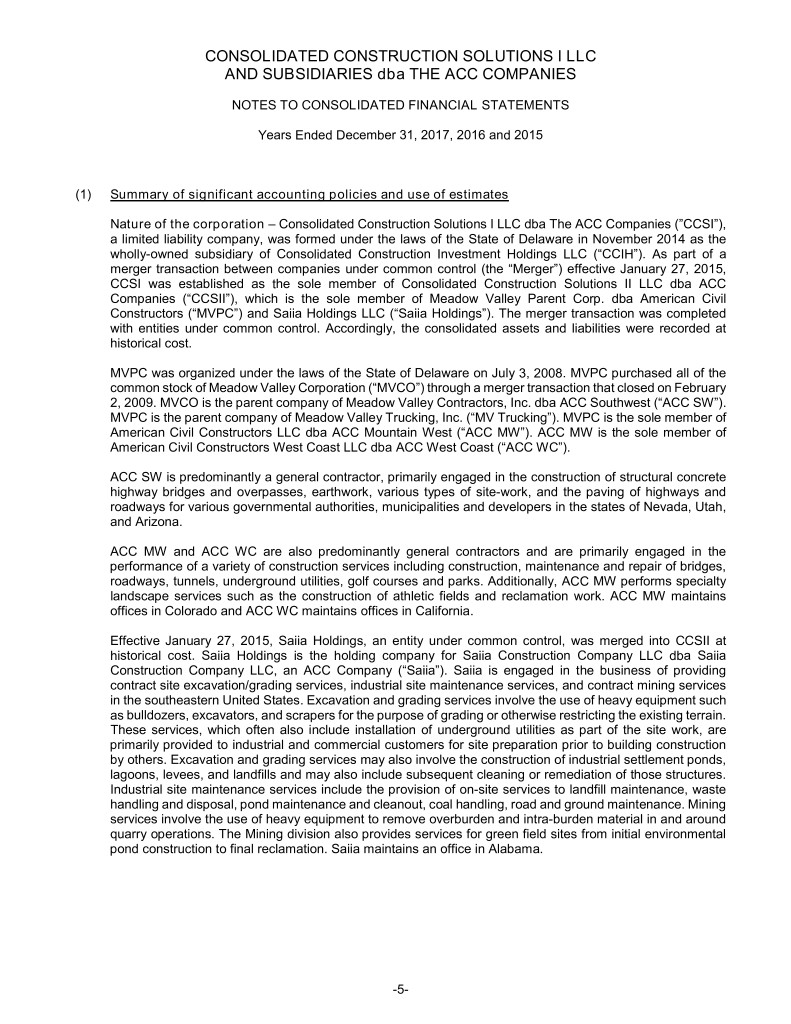
CONSOLIDATED CONSTRUCTION SOLUTIONS I LLC AND SUBSIDIARIES dba THE ACC COMPANIES NOTES TO CONSOLIDATED FINANCIAL STATEMENTS Years Ended December 31, 2017, 2016 and 2015 (1) Summary of significant accounting policies and use of estimates Nature of the corporation – Consolidated Construction Solutions I LLC dba The ACC Companies (”CCSI”), a limited liability company, was formed under the laws of the State of Delaware in November 2014 as the wholly-owned subsidiary of Consolidated Construction Investment Holdings LLC (“CCIH”). As part of a merger transaction between companies under common control (the “Merger”) effective January 27, 2015, CCSI was established as the sole member of Consolidated Construction Solutions II LLC dba ACC Companies (“CCSII”), which is the sole member of Meadow Valley Parent Corp. dba American Civil Constructors (“MVPC”) and Saiia Holdings LLC (“Saiia Holdings”). The merger transaction was completed with entities under common control. Accordingly, the consolidated assets and liabilities were recorded at historical cost. MVPC was organized under the laws of the State of Delaware on July 3, 2008. MVPC purchased all of the common stock of Meadow Valley Corporation (“MVCO”) through a merger transaction that closed on February 2, 2009. MVCO is the parent company of Meadow Valley Contractors, Inc. dba ACC Southwest (“ACC SW”). MVPC is the parent company of Meadow Valley Trucking, Inc. (“MV Trucking”). MVPC is the sole member of American Civil Constructors LLC dba ACC Mountain West (“ACC MW”). ACC MW is the sole member of American Civil Constructors West Coast LLC dba ACC West Coast (“ACC WC”). ACC SW is predominantly a general contractor, primarily engaged in the construction of structural concrete highway bridges and overpasses, earthwork, various types of site-work, and the paving of highways and roadways for various governmental authorities, municipalities and developers in the states of Nevada, Utah, and Arizona. ACC MW and ACC WC are also predominantly general contractors and are primarily engaged in the performance of a variety of construction services including construction, maintenance and repair of bridges, roadways, tunnels, underground utilities, golf courses and parks. Additionally, ACC MW performs specialty landscape services such as the construction of athletic fields and reclamation work. ACC MW maintains offices in Colorado and ACC WC maintains offices in California. Effective January 27, 2015, Saiia Holdings, an entity under common control, was merged into CCSII at historical cost. Saiia Holdings is the holding company for Saiia Construction Company LLC dba Saiia Construction Company LLC, an ACC Company (“Saiia”). Saiia is engaged in the business of providing contract site excavation/grading services, industrial site maintenance services, and contract mining services in the southeastern United States. Excavation and grading services involve the use of heavy equipment such as bulldozers, excavators, and scrapers for the purpose of grading or otherwise restricting the existing terrain. These services, which often also include installation of underground utilities as part of the site work, are primarily provided to industrial and commercial customers for site preparation prior to building construction by others. Excavation and grading services may also involve the construction of industrial settlement ponds, lagoons, levees, and landfills and may also include subsequent cleaning or remediation of those structures. Industrial site maintenance services include the provision of on-site services to landfill maintenance, waste handling and disposal, pond maintenance and cleanout, coal handling, road and ground maintenance. Mining services involve the use of heavy equipment to remove overburden and intra-burden material in and around quarry operations. The Mining division also provides services for green field sites from initial environmental pond construction to final reclamation. Saiia maintains an office in Alabama. -5-
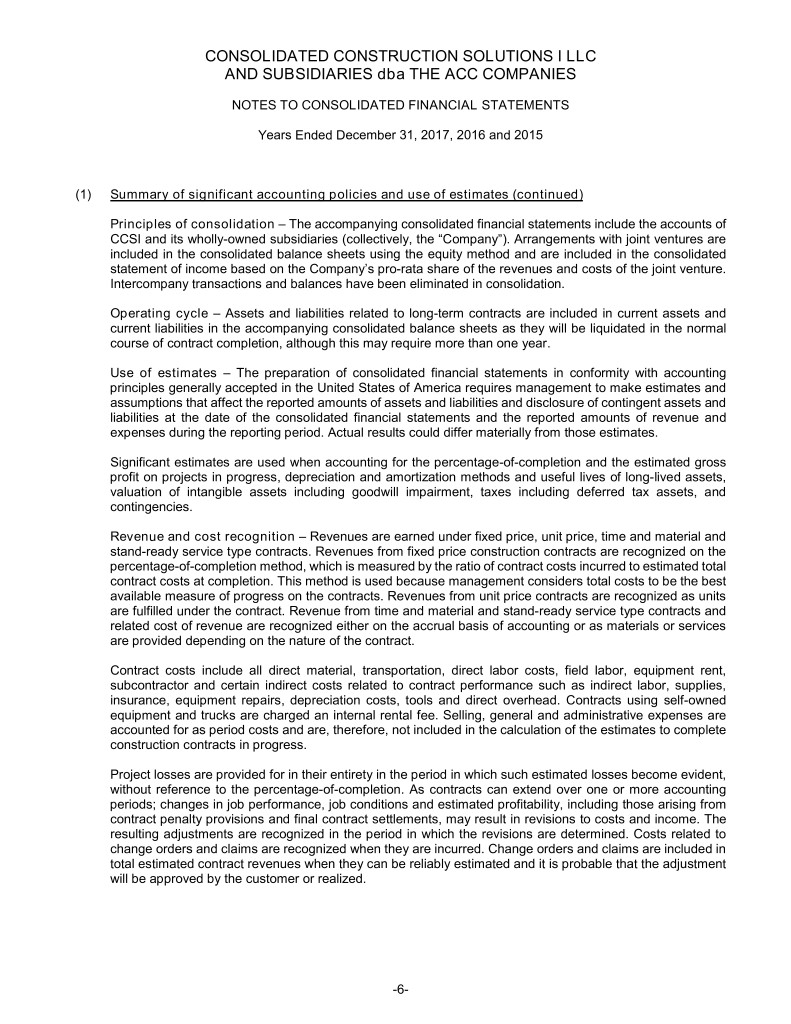
CONSOLIDATED CONSTRUCTION SOLUTIONS I LLC AND SUBSIDIARIES dba THE ACC COMPANIES NOTES TO CONSOLIDATED FINANCIAL STATEMENTS Years Ended December 31, 2017, 2016 and 2015 (1) Summary of significant accounting policies and use of estimates (continued) Principles of consolidation – The accompanying consolidated financial statements include the accounts of CCSI and its wholly-owned subsidiaries (collectively, the “Company”). Arrangements with joint ventures are included in the consolidated balance sheets using the equity method and are included in the consolidated statement of income based on the Company’s pro-rata share of the revenues and costs of the joint venture. Intercompany transactions and balances have been eliminated in consolidation. Operating cycle – Assets and liabilities related to long-term contracts are included in current assets and current liabilities in the accompanying consolidated balance sheets as they will be liquidated in the normal course of contract completion, although this may require more than one year. Use of estimates – The preparation of consolidated financial statements in conformity with accounting principles generally accepted in the United States of America requires management to make estimates and assumptions that affect the reported amounts of assets and liabilities and disclosure of contingent assets and liabilities at the date of the consolidated financial statements and the reported amounts of revenue and expenses during the reporting period. Actual results could differ materially from those estimates. Significant estimates are used when accounting for the percentage-of-completion and the estimated gross profit on projects in progress, depreciation and amortization methods and useful lives of long-lived assets, valuation of intangible assets including goodwill impairment, taxes including deferred tax assets, and contingencies. Revenue and cost recognition – Revenues are earned under fixed price, unit price, time and material and stand-ready service type contracts. Revenues from fixed price construction contracts are recognized on the percentage-of-completion method, which is measured by the ratio of contract costs incurred to estimated total contract costs at completion. This method is used because management considers total costs to be the best available measure of progress on the contracts. Revenues from unit price contracts are recognized as units are fulfilled under the contract. Revenue from time and material and stand-ready service type contracts and related cost of revenue are recognized either on the accrual basis of accounting or as materials or services are provided depending on the nature of the contract. Contract costs include all direct material, transportation, direct labor costs, field labor, equipment rent, subcontractor and certain indirect costs related to contract performance such as indirect labor, supplies, insurance, equipment repairs, depreciation costs, tools and direct overhead. Contracts using self-owned equipment and trucks are charged an internal rental fee. Selling, general and administrative expenses are accounted for as period costs and are, therefore, not included in the calculation of the estimates to complete construction contracts in progress. Project losses are provided for in their entirety in the period in which such estimated losses become evident, without reference to the percentage-of-completion. As contracts can extend over one or more accounting periods; changes in job performance, job conditions and estimated profitability, including those arising from contract penalty provisions and final contract settlements, may result in revisions to costs and income. The resulting adjustments are recognized in the period in which the revisions are determined. Costs related to change orders and claims are recognized when they are incurred. Change orders and claims are included in total estimated contract revenues when they can be reliably estimated and it is probable that the adjustment will be approved by the customer or realized. -6-
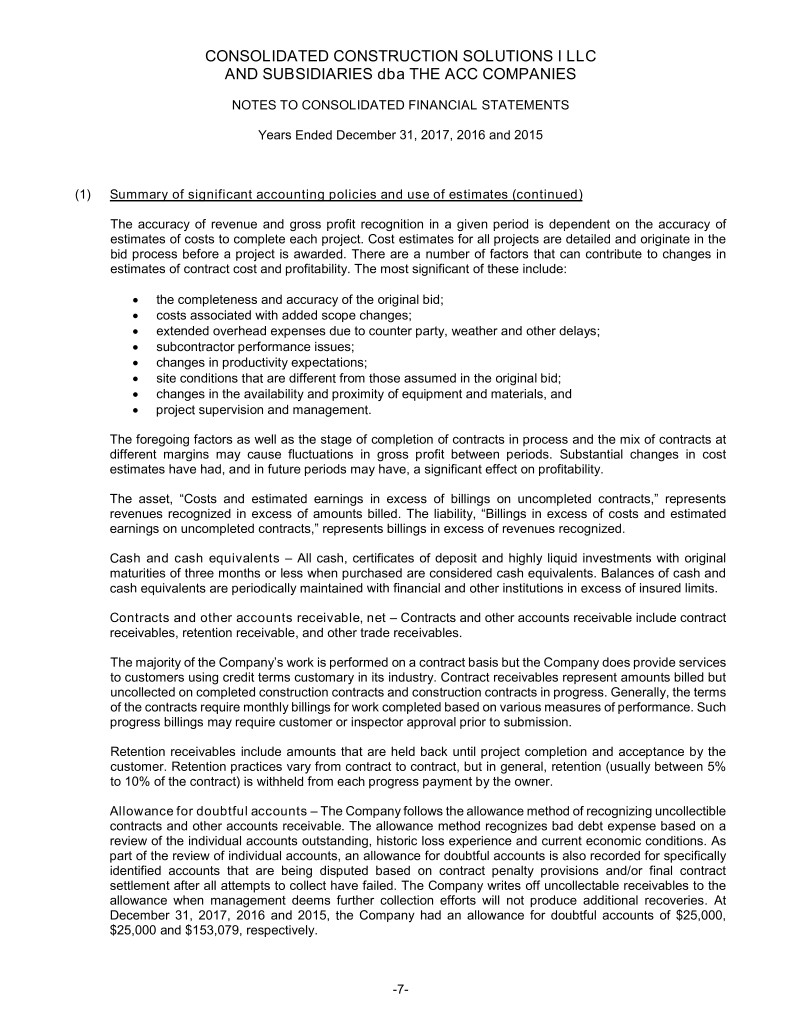
CONSOLIDATED CONSTRUCTION SOLUTIONS I LLC AND SUBSIDIARIES dba THE ACC COMPANIES NOTES TO CONSOLIDATED FINANCIAL STATEMENTS Years Ended December 31, 2017, 2016 and 2015 (1) Summary of significant accounting policies and use of estimates (continued) The accuracy of revenue and gross profit recognition in a given period is dependent on the accuracy of estimates of costs to complete each project. Cost estimates for all projects are detailed and originate in the bid process before a project is awarded. There are a number of factors that can contribute to changes in estimates of contract cost and profitability. The most significant of these include: • the completeness and accuracy of the original bid; • costs associated with added scope changes; • extended overhead expenses due to counter party, weather and other delays; • subcontractor performance issues; • changes in productivity expectations; • site conditions that are different from those assumed in the original bid; • changes in the availability and proximity of equipment and materials, and • project supervision and management. The foregoing factors as well as the stage of completion of contracts in process and the mix of contracts at different margins may cause fluctuations in gross profit between periods. Substantial changes in cost estimates have had, and in future periods may have, a significant effect on profitability. The asset, “Costs and estimated earnings in excess of billings on uncompleted contracts,” represents revenues recognized in excess of amounts billed. The liability, “Billings in excess of costs and estimated earnings on uncompleted contracts,” represents billings in excess of revenues recognized. Cash and cash equivalents – All cash, certificates of deposit and highly liquid investments with original maturities of three months or less when purchased are considered cash equivalents. Balances of cash and cash equivalents are periodically maintained with financial and other institutions in excess of insured limits. Contracts and other accounts receivable, net – Contracts and other accounts receivable include contract receivables, retention receivable, and other trade receivables. The majority of the Company’s work is performed on a contract basis but the Company does provide services to customers using credit terms customary in its industry. Contract receivables represent amounts billed but uncollected on completed construction contracts and construction contracts in progress. Generally, the terms of the contracts require monthly billings for work completed based on various measures of performance. Such progress billings may require customer or inspector approval prior to submission. Retention receivables include amounts that are held back until project completion and acceptance by the customer. Retention practices vary from contract to contract, but in general, retention (usually between 5% to 10% of the contract) is withheld from each progress payment by the owner. Allowance for doubtful accounts – The Company follows the allowance method of recognizing uncollectible contracts and other accounts receivable. The allowance method recognizes bad debt expense based on a review of the individual accounts outstanding, historic loss experience and current economic conditions. As part of the review of individual accounts, an allowance for doubtful accounts is also recorded for specifically identified accounts that are being disputed based on contract penalty provisions and/or final contract settlement after all attempts to collect have failed. The Company writes off uncollectable receivables to the allowance when management deems further collection efforts will not produce additional recoveries. At December 31, 2017, 2016 and 2015, the Company had an allowance for doubtful accounts of $25,000, $25,000 and $153,079, respectively. -7-

CONSOLIDATED CONSTRUCTION SOLUTIONS I LLC AND SUBSIDIARIES dba THE ACC COMPANIES NOTES TO CONSOLIDATED FINANCIAL STATEMENTS Years Ended December 31, 2017, 2016 and 2015 (1) Summary of significant accounting policies and use of estimates (continued) Inventory – Inventories are comprised primarily of construction materials that are used over the lifespan of more than one construction project in process. Inventories are valued at the lower of cost or net realizable value and are charged as a direct project cost when expended. At December 31, 2017, 2016 and 2015, the Company had no amounts recorded as an allowance for potentially obsolete or slow moving inventory. Property and equipment – Property and equipment are stated at cost. Additions and improvements are capitalized while ordinary maintenance and repaid expenditures are expensed as incurred. The cost of property and equipment is depreciated using the straight-line method over the estimated useful lives of 1 to 20 years. Leasehold improvements are recorded at cost and are amortized over their estimated useful lives or the lease term, whichever is shorter. Impairment of long-lived assets – Long-lived assets are reviewed for impairment whenever events or changes in circumstances indicate that the related carrying amount may not be recoverable. Recoverability of assets to be held and used is measured by a comparison of the carrying amount of such assets to future undiscounted net cash flows expected to be generated by the assets. If such assets are considered to be impaired, the impairment to be recognized is measured as the amount by which the carrying amount of the assets exceeds the fair value of the assets. During the years ended December 31, 2017, 2016 and 2015, no impairment charges on long-lived assets were recorded. Assets held for sale – An asset is classified as held for sale when (i) management commits to a plan to sell and it is actively marketed; (ii) it is available for immediate sale and the sale is expected to be completed within one year, and (iii) it is unlikely significant changes to the plan will be made or that the plan will be withdrawn. Upon being classified as held for sale, the recoverability of the carrying value of the assets must be assessed, reported at the lower of the carrying value or fair value less costs to sell and the assets are no longer depreciated or amortized. During the years ended December 31, 2017, 2016 and 2015, the Company recorded approximately $152,000, $0 and $0, respectively, of impairment charges on assets held for sale. The impairment charges were based on current market prices from sales transactions for land parcels being held for sale. Goodwill and other intangible assets – Intangible assets resulting from business combinations consist primarily of backlog, customer relationships, non-compete agreement, tradenames and goodwill. Intangible assets with finite lives are amortized over the period that the Company believes best reflects the period in which economic benefits will be utilized. The Company evaluates intangible assets with finite lives for recoverability when events or changes in circumstances indicate that these assets might be impaired. Intangible assets with indefinite lives are tested for impairment annually or more frequently if events or changes in circumstances indicate that the assets might be impaired. The Company has the option to perform a qualitative analysis before comparing their respective carrying values to estimates of the sum of the undiscounted future net cash flows expected to result from the assets, in determining whether assets are impaired. -8-
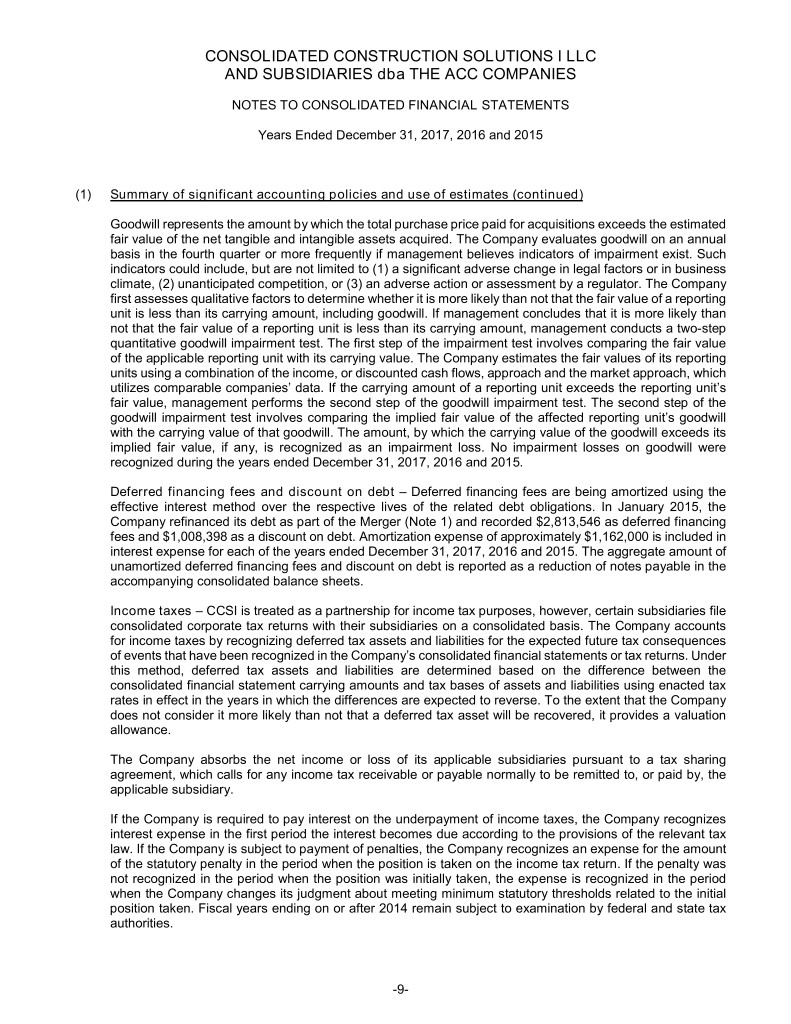
CONSOLIDATED CONSTRUCTION SOLUTIONS I LLC AND SUBSIDIARIES dba THE ACC COMPANIES NOTES TO CONSOLIDATED FINANCIAL STATEMENTS Years Ended December 31, 2017, 2016 and 2015 (1) Summary of significant accounting policies and use of estimates (continued) Goodwill represents the amount by which the total purchase price paid for acquisitions exceeds the estimated fair value of the net tangible and intangible assets acquired. The Company evaluates goodwill on an annual basis in the fourth quarter or more frequently if management believes indicators of impairment exist. Such indicators could include, but are not limited to (1) a significant adverse change in legal factors or in business climate, (2) unanticipated competition, or (3) an adverse action or assessment by a regulator. The Company first assesses qualitative factors to determine whether it is more likely than not that the fair value of a reporting unit is less than its carrying amount, including goodwill. If management concludes that it is more likely than not that the fair value of a reporting unit is less than its carrying amount, management conducts a two-step quantitative goodwill impairment test. The first step of the impairment test involves comparing the fair value of the applicable reporting unit with its carrying value. The Company estimates the fair values of its reporting units using a combination of the income, or discounted cash flows, approach and the market approach, which utilizes comparable companies’ data. If the carrying amount of a reporting unit exceeds the reporting unit’s fair value, management performs the second step of the goodwill impairment test. The second step of the goodwill impairment test involves comparing the implied fair value of the affected reporting unit’s goodwill with the carrying value of that goodwill. The amount, by which the carrying value of the goodwill exceeds its implied fair value, if any, is recognized as an impairment loss. No impairment losses on goodwill were recognized during the years ended December 31, 2017, 2016 and 2015. Deferred financing fees and discount on debt – Deferred financing fees are being amortized using the effective interest method over the respective lives of the related debt obligations. In January 2015, the Company refinanced its debt as part of the Merger (Note 1) and recorded $2,813,546 as deferred financing fees and $1,008,398 as a discount on debt. Amortization expense of approximately $1,162,000 is included in interest expense for each of the years ended December 31, 2017, 2016 and 2015. The aggregate amount of unamortized deferred financing fees and discount on debt is reported as a reduction of notes payable in the accompanying consolidated balance sheets. Income taxes – CCSI is treated as a partnership for income tax purposes, however, certain subsidiaries file consolidated corporate tax returns with their subsidiaries on a consolidated basis. The Company accounts for income taxes by recognizing deferred tax assets and liabilities for the expected future tax consequences of events that have been recognized in the Company’s consolidated financial statements or tax returns. Under this method, deferred tax assets and liabilities are determined based on the difference between the consolidated financial statement carrying amounts and tax bases of assets and liabilities using enacted tax rates in effect in the years in which the differences are expected to reverse. To the extent that the Company does not consider it more likely than not that a deferred tax asset will be recovered, it provides a valuation allowance. The Company absorbs the net income or loss of its applicable subsidiaries pursuant to a tax sharing agreement, which calls for any income tax receivable or payable normally to be remitted to, or paid by, the applicable subsidiary. If the Company is required to pay interest on the underpayment of income taxes, the Company recognizes interest expense in the first period the interest becomes due according to the provisions of the relevant tax law. If the Company is subject to payment of penalties, the Company recognizes an expense for the amount of the statutory penalty in the period when the position is taken on the income tax return. If the penalty was not recognized in the period when the position was initially taken, the expense is recognized in the period when the Company changes its judgment about meeting minimum statutory thresholds related to the initial position taken. Fiscal years ending on or after 2014 remain subject to examination by federal and state tax authorities. -9-
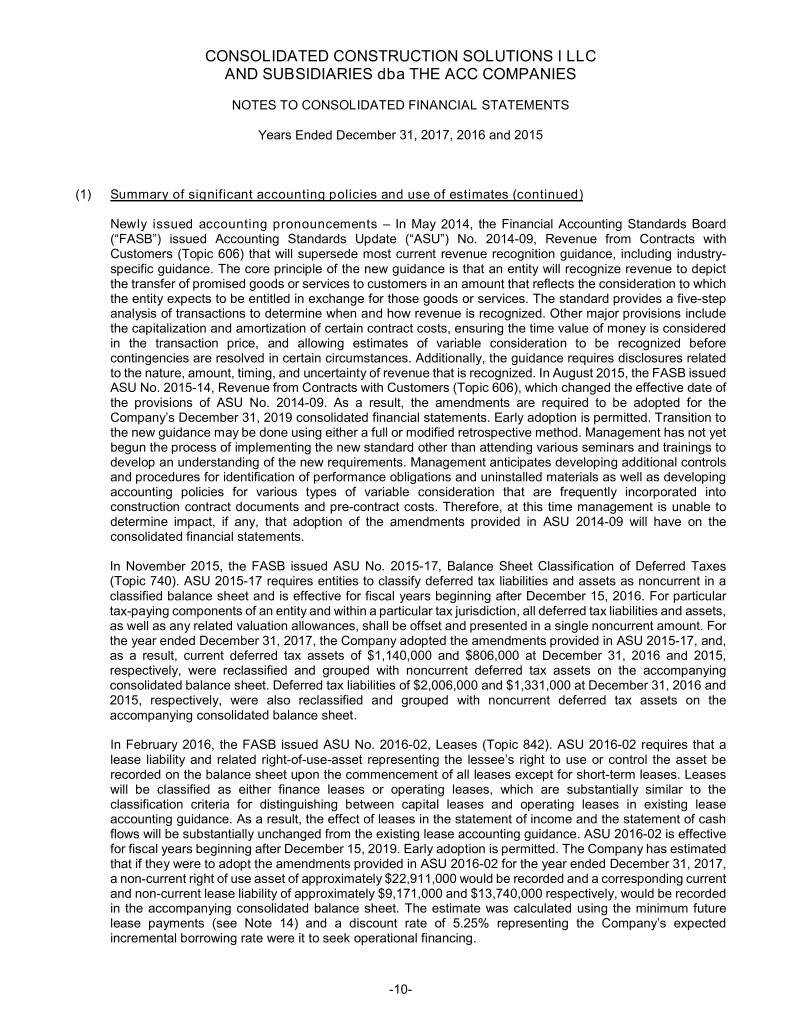
CONSOLIDATED CONSTRUCTION SOLUTIONS I LLC AND SUBSIDIARIES dba THE ACC COMPANIES NOTES TO CONSOLIDATED FINANCIAL STATEMENTS Years Ended December 31, 2017, 2016 and 2015 (1) Summary of significant accounting policies and use of estimates (continued) Newly issued accounting pronouncements – In May 2014, the Financial Accounting Standards Board (“FASB”) issued Accounting Standards Update (“ASU”) No. 2014-09, Revenue from Contracts with Customers (Topic 606) that will supersede most current revenue recognition guidance, including industry- specific guidance. The core principle of the new guidance is that an entity will recognize revenue to depict the transfer of promised goods or services to customers in an amount that reflects the consideration to which the entity expects to be entitled in exchange for those goods or services. The standard provides a five-step analysis of transactions to determine when and how revenue is recognized. Other major provisions include the capitalization and amortization of certain contract costs, ensuring the time value of money is considered in the transaction price, and allowing estimates of variable consideration to be recognized before contingencies are resolved in certain circumstances. Additionally, the guidance requires disclosures related to the nature, amount, timing, and uncertainty of revenue that is recognized. In August 2015, the FASB issued ASU No. 2015-14, Revenue from Contracts with Customers (Topic 606), which changed the effective date of the provisions of ASU No. 2014-09. As a result, the amendments are required to be adopted for the Company’s December 31, 2019 consolidated financial statements. Early adoption is permitted. Transition to the new guidance may be done using either a full or modified retrospective method. Management has not yet begun the process of implementing the new standard other than attending various seminars and trainings to develop an understanding of the new requirements. Management anticipates developing additional controls and procedures for identification of performance obligations and uninstalled materials as well as developing accounting policies for various types of variable consideration that are frequently incorporated into construction contract documents and pre-contract costs. Therefore, at this time management is unable to determine impact, if any, that adoption of the amendments provided in ASU 2014-09 will have on the consolidated financial statements. In November 2015, the FASB issued ASU No. 2015-17, Balance Sheet Classification of Deferred Taxes (Topic 740). ASU 2015-17 requires entities to classify deferred tax liabilities and assets as noncurrent in a classified balance sheet and is effective for fiscal years beginning after December 15, 2016. For particular tax-paying components of an entity and within a particular tax jurisdiction, all deferred tax liabilities and assets, as well as any related valuation allowances, shall be offset and presented in a single noncurrent amount. For the year ended December 31, 2017, the Company adopted the amendments provided in ASU 2015-17, and, as a result, current deferred tax assets of $1,140,000 and $806,000 at December 31, 2016 and 2015, respectively, were reclassified and grouped with noncurrent deferred tax assets on the accompanying consolidated balance sheet. Deferred tax liabilities of $2,006,000 and $1,331,000 at December 31, 2016 and 2015, respectively, were also reclassified and grouped with noncurrent deferred tax assets on the accompanying consolidated balance sheet. In February 2016, the FASB issued ASU No. 2016-02, Leases (Topic 842). ASU 2016-02 requires that a lease liability and related right-of-use-asset representing the lessee’s right to use or control the asset be recorded on the balance sheet upon the commencement of all leases except for short-term leases. Leases will be classified as either finance leases or operating leases, which are substantially similar to the classification criteria for distinguishing between capital leases and operating leases in existing lease accounting guidance. As a result, the effect of leases in the statement of income and the statement of cash flows will be substantially unchanged from the existing lease accounting guidance. ASU 2016-02 is effective for fiscal years beginning after December 15, 2019. Early adoption is permitted. The Company has estimated that if they were to adopt the amendments provided in ASU 2016-02 for the year ended December 31, 2017, a non-current right of use asset of approximately $22,911,000 would be recorded and a corresponding current and non-current lease liability of approximately $9,171,000 and $13,740,000 respectively, would be recorded in the accompanying consolidated balance sheet. The estimate was calculated using the minimum future lease payments (see Note 14) and a discount rate of 5.25% representing the Company’s expected incremental borrowing rate were it to seek operational financing. -10-

CONSOLIDATED CONSTRUCTION SOLUTIONS I LLC AND SUBSIDIARIES dba THE ACC COMPANIES NOTES TO CONSOLIDATED FINANCIAL STATEMENTS Years Ended December 31, 2017, 2016 and 2015 (2) Contracts and other accounts receivable, net Contracts and other accounts receivable, net consists of the following at December 31: 2017 2016 2015 Contracts in progress $ 38,600,404 $ 31,364,650 $ 31,388,716 Contracts in progress - retention 12,067,370 9,153,652 6,863,249 Completed contracts 10,515 100,983 129,558 Completed contracts - retention 68,752 66,958 - Trade receivables - - 142,974 Other receivables 168,525 341,699 1,002,521 50,915,566 41,027,942 39,527,018 Allowance for doubtful accounts (25,000) (25,000) (153,079) $ 50,890,566 $ 41,002,942 $ 39,373,939 The balances billed but not paid by customers pursuant to retainage provisions in construction contracts generally become due upon completion of the contracts and acceptance by the owners. Retainage amounts of $12,136,122 at December 31, 2017 are expected to be collected at the end of the contracts. (3) Costs and estimated earnings on uncompleted contracts Costs and estimated earnings on uncompleted contracts as of December 31 are summarized as follows: 2017 2016 2015 Costs incurred on uncompleted contracts $ 452,196,715 $ 486,905,869 $ 486,145,494 Estimated earnings to date 70,101,117 68,624,569 54,295,122 522,297,832 555,530,438 540,440,616 Less: billings to date (534,767,877) (566,059,593) (546,657,860) $ (12,470,045) $ (10,529,155) $ (6,217,244) Included in the accompanying consolidated balance sheets under the following captions for December 31: 2017 2016 2015 Costs and estimated earnings in excess of billings on uncompleted contracts $ 3,827,436 $ 4,391,081 $ 4,950,754 Billings in excess of costs and estimated earnings on uncompleted contracts (16,297,481) (14,920,236) (11,167,998) $ (12,470,045) $ (10,529,155) $ (6,217,244) -11-

CONSOLIDATED CONSTRUCTION SOLUTIONS I LLC AND SUBSIDIARIES dba THE ACC COMPANIES NOTES TO CONSOLIDATED FINANCIAL STATEMENTS Years Ended December 31, 2017, 2016 and 2015 (4) Property and equipment, net Property and equipment, net as of December 31 consist of the following: 2017 2016 2015 Land $ 860,000 $ 860,000 $ 860,000 Buildings and improvements 2,539,623 2,092,785 2,092,785 Computer & office equipment 1,807,360 1,758,905 1,665,068 Machinery & equipment 63,943,896 61,241,345 56,418,601 Trucks & trailers 12,535,321 11,968,648 11,647,836 Leasehold improvements 86,111 86,111 91,202 81,772,311 78,007,794 72,775,492 Less: Accumulated depreciation (43,100,156) (39,159,922) (35,844,097) $ 38,672,155 $ 38,847,872 $ 36,931,395 Depreciation expense for the years ended December 31, 2017, 2016 and 2015 was $8,014,227, $7,466,360, and $6,689,618 respectively. (5) Goodwill and intangible assets Goodwill represents the amount by which the total purchase price paid for Saiia exceeded the estimated fair value of the identifiable net assets acquired. Intangible assets were acquired in acquisition transactions related to ACC MW, Saiia, and ACC SW. The estimated useful lives of intangible assets are as follows: Estimated Useful Life Customer relationships 2 - 12 years Developed technology 5 years Trade name Indefinite Trademarks 7 - 8 years The carrying value of goodwill and intangible assets at December 31 was as follows: 2017 2016 2015 Customer relationships $ 1,900,000 $ 1,957,000 $ 1,957,000 Developed technology - - 800,000 Trade name 792,000 792,000 792,000 Trademarks 600,000 600,000 600,000 3,292,000 3,349,000 4,149,000 Less: Accumulated amortization (1,681,004) (1,501,956) (2,060,480) $ 1,610,996 $ 1,847,044 $ 2,088,520 Goodwill $ 714,549 $ 714,549 $ 714,549 Less: Accumulated impairment - - - $ 714,549 $ 714,549 $ 714,549 -12-

CONSOLIDATED CONSTRUCTION SOLUTIONS I LLC AND SUBSIDIARIES dba THE ACC COMPANIES NOTES TO CONSOLIDATED FINANCIAL STATEMENTS Years Ended December 31, 2017, 2016 and 2015 (5) Goodwill and intangible assets (continued) Certain customer relationship intangibles were fully amortized as of April 2017 and the developed technology was fully amortized as of October 2015. As a result, the related cost and accumulated amortization of $57,000 and $800,000 was removed during 2017 and 2016, respectively. Amortization expense associated with intangible assets with definite lives was $236,048, $241,476 and $492,584 for the years ended December 31, 2017, 2016 and 2015, respectively Estimated annual amortization expense for each of the five succeeding years is as follows: Total 2018 $ 218,010 2019 158,333 2020 158,333 2021 158,333 2022 125,987 Total $ 818,996 (6) Accounts payable Accounts payable consists of the following at December 31: 2017 2016 2015 Trade $ 11,345,341 $ 10,419,332 $ 9,677,284 Subcontractors 5,579,203 5,152,700 6,909,984 Retentions 2,548,747 2,064,467 1,733,579 $ 19,473,291 $ 17,636,499 $ 18,320,847 (7) Accrued liabilities Accrued liabilities consist of the following at December 31: 2017 2016 2015 Compensation $ 5,444,159 $ 4,858,411 $ 4,397,957 Taxes 456,694 452,275 366,549 Insurance 1,137,055 3,641,450 4,052,595 Other 1,184,891 2,960,458 1,546,500 $ 8,222,799 $ 11,912,594 $ 10,363,601 (8) Line of credit At January 1, 2016, the Company had a $10.0 million line of credit with Regions Bank. The line of credit was collateralized by substantially all assets of the Company and matured in January 2018. -13-
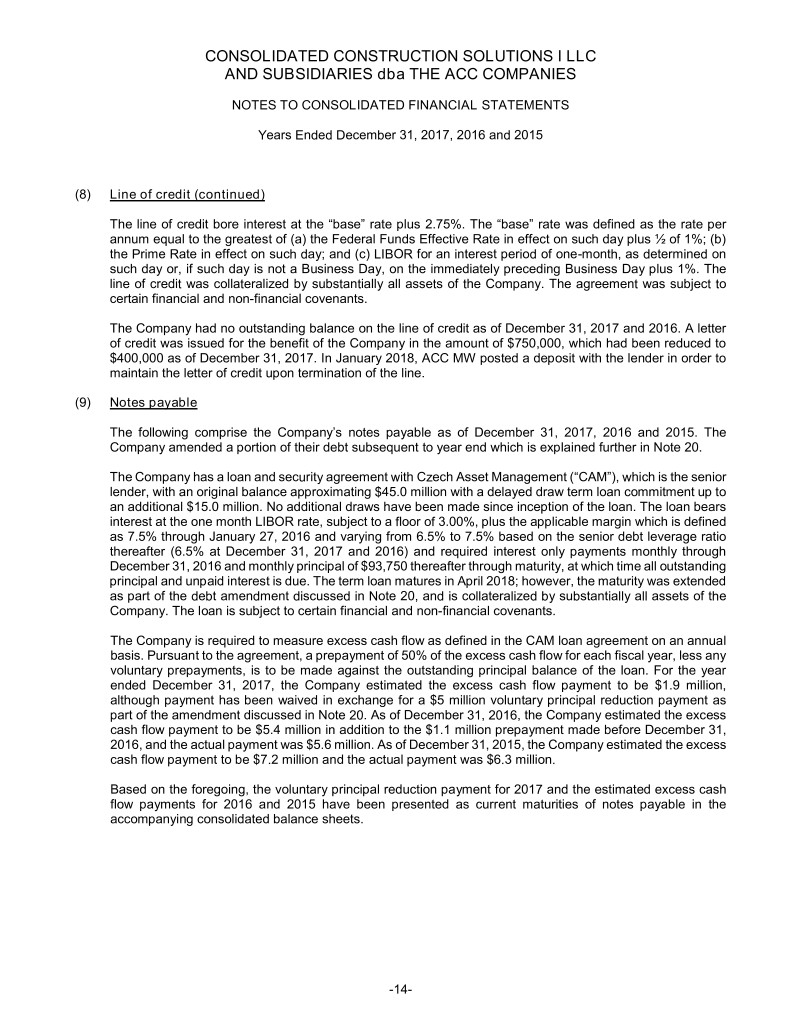
CONSOLIDATED CONSTRUCTION SOLUTIONS I LLC AND SUBSIDIARIES dba THE ACC COMPANIES NOTES TO CONSOLIDATED FINANCIAL STATEMENTS Years Ended December 31, 2017, 2016 and 2015 (8) Line of credit (continued) The line of credit bore interest at the “base” rate plus 2.75%. The “base” rate was defined as the rate per annum equal to the greatest of (a) the Federal Funds Effective Rate in effect on such day plus ½ of 1%; (b) the Prime Rate in effect on such day; and (c) LIBOR for an interest period of one-month, as determined on such day or, if such day is not a Business Day, on the immediately preceding Business Day plus 1%. The line of credit was collateralized by substantially all assets of the Company. The agreement was subject to certain financial and non-financial covenants. The Company had no outstanding balance on the line of credit as of December 31, 2017 and 2016. A letter of credit was issued for the benefit of the Company in the amount of $750,000, which had been reduced to $400,000 as of December 31, 2017. In January 2018, ACC MW posted a deposit with the lender in order to maintain the letter of credit upon termination of the line. (9) Notes payable The following comprise the Company’s notes payable as of December 31, 2017, 2016 and 2015. The Company amended a portion of their debt subsequent to year end which is explained further in Note 20. The Company has a loan and security agreement with Czech Asset Management (“CAM”), which is the senior lender, with an original balance approximating $45.0 million with a delayed draw term loan commitment up to an additional $15.0 million. No additional draws have been made since inception of the loan. The loan bears interest at the one month LIBOR rate, subject to a floor of 3.00%, plus the applicable margin which is defined as 7.5% through January 27, 2016 and varying from 6.5% to 7.5% based on the senior debt leverage ratio thereafter (6.5% at December 31, 2017 and 2016) and required interest only payments monthly through December 31, 2016 and monthly principal of $93,750 thereafter through maturity, at which time all outstanding principal and unpaid interest is due. The term loan matures in April 2018; however, the maturity was extended as part of the debt amendment discussed in Note 20, and is collateralized by substantially all assets of the Company. The loan is subject to certain financial and non-financial covenants. The Company is required to measure excess cash flow as defined in the CAM loan agreement on an annual basis. Pursuant to the agreement, a prepayment of 50% of the excess cash flow for each fiscal year, less any voluntary prepayments, is to be made against the outstanding principal balance of the loan. For the year ended December 31, 2017, the Company estimated the excess cash flow payment to be $1.9 million, although payment has been waived in exchange for a $5 million voluntary principal reduction payment as part of the amendment discussed in Note 20. As of December 31, 2016, the Company estimated the excess cash flow payment to be $5.4 million in addition to the $1.1 million prepayment made before December 31, 2016, and the actual payment was $5.6 million. As of December 31, 2015, the Company estimated the excess cash flow payment to be $7.2 million and the actual payment was $6.3 million. Based on the foregoing, the voluntary principal reduction payment for 2017 and the estimated excess cash flow payments for 2016 and 2015 have been presented as current maturities of notes payable in the accompanying consolidated balance sheets. -14-

CONSOLIDATED CONSTRUCTION SOLUTIONS I LLC AND SUBSIDIARIES dba THE ACC COMPANIES NOTES TO CONSOLIDATED FINANCIAL STATEMENTS Years Ended December 31, 2017, 2016 and 2015 (9) Notes payable (continued) The Company has a term loan and security agreement with LBC Credit Partners II, L.P., LBC Credit Partners Parallel II, L.P. (collectively, “LBC”) and Insight Equity MVCO Mezz Debt LLC (“Insight Equity”) with an original balance of approximately $28.3 million. The outstanding principal bears interest at a rate less than or equal to 7.0% plus paid-in-kind (“PIK”) interest that accrues to the principal balance at a rate no less than 5% as defined by certain financial covenant measurements stipulated by the loan agreement. The total interest rate is not to exceed 14% annually. The loan matures in October 2018; however, the maturity was extended as part of the debt amendment discussed in Note 20, and is collateralized by liens and security interests granted on substantially all property of the Company and is subordinate to the CAM note payable. The loan is subject to certain financial and non-financial covenants. During the years ended December 31, 2017, 2016 and 2015, PIK interest incurred of $1,451,610, $1,429,789 and $1,340,385 was added to the outstanding balance of the LBC and Insight Equity loans. Long-term debt consists of the following at December 31: 2017 2016 2015 Notes payable to various finance companies for property and equipment, with monthly payments from $832 to $6,550; interest rates ranging from 0% to 7.18%; maturing from August 2018 to August 2021; collateralized by property and equipment. $ 1,029,540 $ 1,580,114 $ 1,659,941 Notes payable to Caterpillar Financial for property and equipment, with monthly payments from $313 to $22,353; interest rates ranging from 4.18% to 5.95%; maturing from December 2018 to May 2022; monthly interest-only payments of 10.5%; collateralized by property and equipment. 4,632,955 5,641,964 4,653,036 Note payable to Czech Asset Management, with monthly interest-only payments of 9.50% to 10.5%; maturing in April 2018, collateralized by all assets. 30,487,209 37,203,035 45,000,000 Notes payable to LBC and Insight Equity, with monthly interest only payments of 7.0%; incurs PIK at 5.0%; maturing October 2018; collateralized by all assets. 29,505,659 28,054,049 29,624,260 Total notes payable 65,655,363 72,479,162 80,937,237 Less: current portion (8,413,465) (7,735,302) (10,643,273) Less: unamortized discount and debt issuance costs (432,364) (1,594,506) (2,756,647) Non-current portion $ 56,809,534 $ 63,149,354 $ 67,537,317 -15-
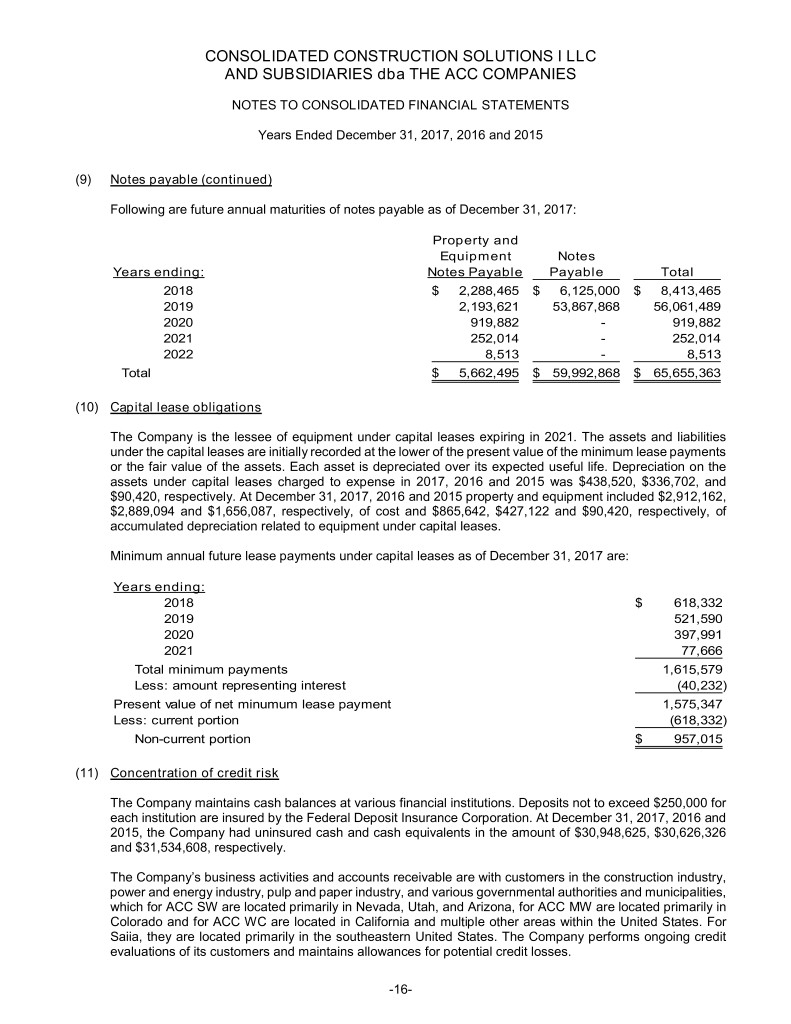
CONSOLIDATED CONSTRUCTION SOLUTIONS I LLC AND SUBSIDIARIES dba THE ACC COMPANIES NOTES TO CONSOLIDATED FINANCIAL STATEMENTS Years Ended December 31, 2017, 2016 and 2015 (9) Notes payable (continued) Following are future annual maturities of notes payable as of December 31, 2017: Property and Equipment Notes Years ending: Notes Payable Payable Total 2018 $ 2,288,465 $ 6,125,000 $ 8,413,465 2019 2,193,621 53,867,868 56,061,489 2020 919,882 - 919,882 2021 252,014 - 252,014 2022 8,513 - 8,513 Total $ 5,662,495 $ 59,992,868 $ 65,655,363 (10) Capital lease obligations The Company is the lessee of equipment under capital leases expiring in 2021. The assets and liabilities under the capital leases are initially recorded at the lower of the present value of the minimum lease payments or the fair value of the assets. Each asset is depreciated over its expected useful life. Depreciation on the assets under capital leases charged to expense in 2017, 2016 and 2015 was $438,520, $336,702, and $90,420, respectively. At December 31, 2017, 2016 and 2015 property and equipment included $2,912,162, $2,889,094 and $1,656,087, respectively, of cost and $865,642, $427,122 and $90,420, respectively, of accumulated depreciation related to equipment under capital leases. Minimum annual future lease payments under capital leases as of December 31, 2017 are: Years ending: 2018 $ 618,332 2019 521,590 2020 397,991 2021 77,666 Total minimum payments 1,615,579 Less: amount representing interest (40,232) Present value of net minumum lease payment 1,575,347 Less: current portion (618,332) Non-current portion $ 957,015 (11) Concentration of credit risk The Company maintains cash balances at various financial institutions. Deposits not to exceed $250,000 for each institution are insured by the Federal Deposit Insurance Corporation. At December 31, 2017, 2016 and 2015, the Company had uninsured cash and cash equivalents in the amount of $30,948,625, $30,626,326 and $31,534,608, respectively. The Company’s business activities and accounts receivable are with customers in the construction industry, power and energy industry, pulp and paper industry, and various governmental authorities and municipalities, which for ACC SW are located primarily in Nevada, Utah, and Arizona, for ACC MW are located primarily in Colorado and for ACC WC are located in California and multiple other areas within the United States. For Saiia, they are located primarily in the southeastern United States. The Company performs ongoing credit evaluations of its customers and maintains allowances for potential credit losses. -16-
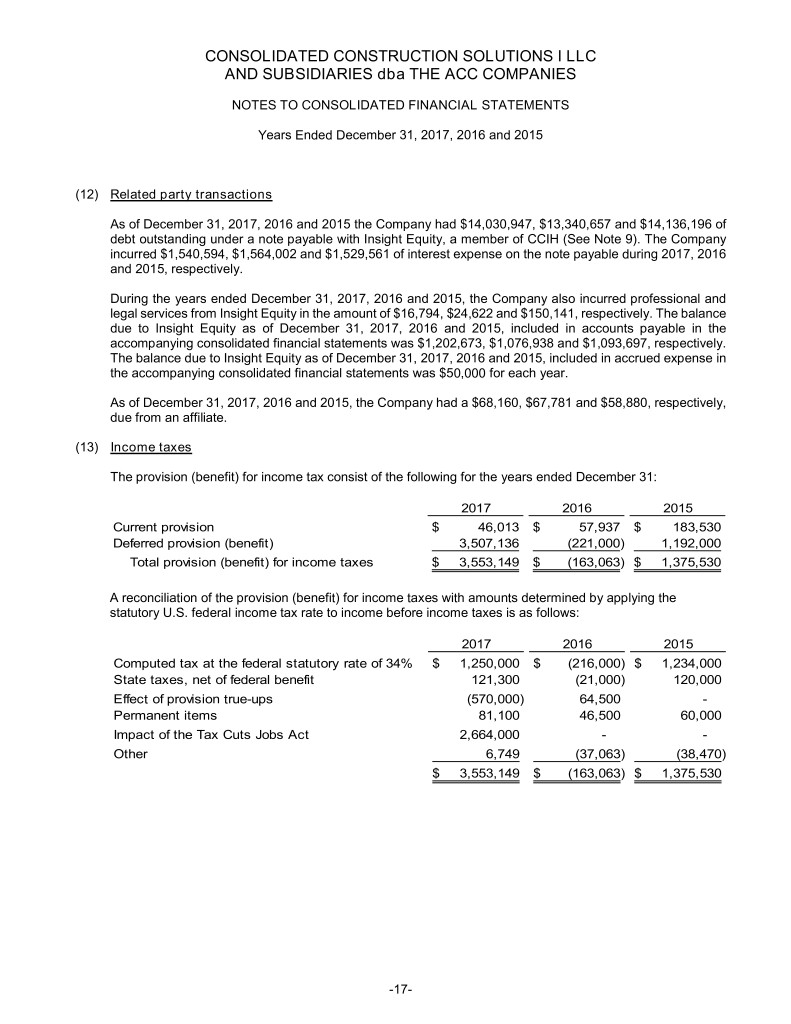
CONSOLIDATED CONSTRUCTION SOLUTIONS I LLC AND SUBSIDIARIES dba THE ACC COMPANIES NOTES TO CONSOLIDATED FINANCIAL STATEMENTS Years Ended December 31, 2017, 2016 and 2015 (12) Related party transactions As of December 31, 2017, 2016 and 2015 the Company had $14,030,947, $13,340,657 and $14,136,196 of debt outstanding under a note payable with Insight Equity, a member of CCIH (See Note 9). The Company incurred $1,540,594, $1,564,002 and $1,529,561 of interest expense on the note payable during 2017, 2016 and 2015, respectively. During the years ended December 31, 2017, 2016 and 2015, the Company also incurred professional and legal services from Insight Equity in the amount of $16,794, $24,622 and $150,141, respectively. The balance due to Insight Equity as of December 31, 2017, 2016 and 2015, included in accounts payable in the accompanying consolidated financial statements was $1,202,673, $1,076,938 and $1,093,697, respectively. The balance due to Insight Equity as of December 31, 2017, 2016 and 2015, included in accrued expense in the accompanying consolidated financial statements was $50,000 for each year. As of December 31, 2017, 2016 and 2015, the Company had a $68,160, $67,781 and $58,880, respectively, due from an affiliate. (13) Income taxes The provision (benefit) for income tax consist of the following for the years ended December 31: 2017 2016 2015 Current provision $ 46,013 $ 57,937 $ 183,530 Deferred provision (benefit) 3,507,136 (221,000) 1,192,000 Total provision (benefit) for income taxes $ 3,553,149 $ (163,063) $ 1,375,530 A reconciliation of the provision (benefit) for income taxes with amounts determined by applying the statutory U.S. federal income tax rate to income before income taxes is as follows: 2017 2016 2015 Computed tax at the federal statutory rate of 34% $ 1,250,000 $ (216,000) $ 1,234,000 State taxes, net of federal benefit 121,300 (21,000) 120,000 Effect of provision true-ups (570,000) 64,500 - Permanent items 81,100 46,500 60,000 Impact of the Tax Cuts Jobs Act 2,664,000 - - Other 6,749 (37,063) (38,470) $ 3,553,149 $ (163,063) $ 1,375,530 -17-

CONSOLIDATED CONSTRUCTION SOLUTIONS I LLC AND SUBSIDIARIES dba THE ACC COMPANIES NOTES TO CONSOLIDATED FINANCIAL STATEMENTS Years Ended December 31, 2017, 2016 and 2015 (13) Income taxes (continued) The Company’s net deferred tax asset consists of the following at December 31: 2017 2016 2015 Deferred tax assets (liabilities): IBNR Accrual $ - $ - $ 40,000 Other accrued expenses 61,521 242,000 635,000 Deferred compensation 676,652 856,000 82,000 Other 27,272 42,000 - Net operating loss carryforwards 5,835,919 10,033,700 13,809,000 Deferred financing costs 49,138 114,000 151,000 Allowance for doubtful accounts - 257,000 469,000 Depreciation and amortization (875,938) (2,006,000) (1,331,000) $ 5,774,564 $ 9,538,700 $ 13,855,000 Less: valuation allowance - (257,000) (4,762,000) Net deferred tax asset $ 5,774,564 $ 9,281,700 $ 9,093,000 The Company’s effective tax rate differs from the federal statutory rate primarily due to the change in federal corporate tax rate, state income taxes and permanent differences related to nondeductible items. At December 31, 2017, the Company has federal net operating loss carryforwards in the amount of approximately $22.5 million, which may be available to offset federal and state taxable income and will expire through 2032. Pursuant to the Internal Revenue Code, utilization of the Company’s net operating loss carryforwards may be limited. Deferred tax assets and liabilities are adjusted for the effects of changes in tax laws and rates on the date of enactment. The Tax Cuts and Jobs Act (“TCJA”) was signed into law on December 22, 2017, which decreased the federal enacted tax rate to a flat 21%. The Company, recorded an estimated $3.1 million expense from the impact of changes in the tax rate on deferred tax assets and liabilities. The Company re-measured the deferred taxes to reflect the reduced rate that will apply when these deferred taxes are settled or realized in future periods based on the enacted tax rates in the TCJA. -18-
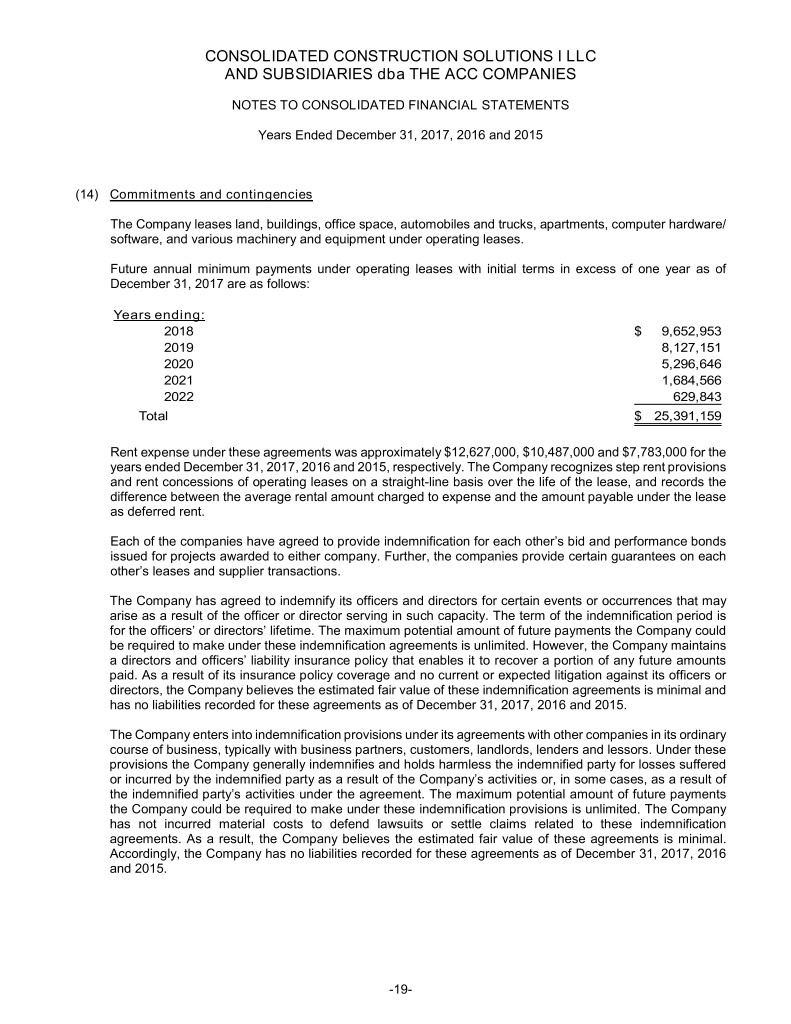
CONSOLIDATED CONSTRUCTION SOLUTIONS I LLC AND SUBSIDIARIES dba THE ACC COMPANIES NOTES TO CONSOLIDATED FINANCIAL STATEMENTS Years Ended December 31, 2017, 2016 and 2015 (14) Commitments and contingencies The Company leases land, buildings, office space, automobiles and trucks, apartments, computer hardware/ software, and various machinery and equipment under operating leases. Future annual minimum payments under operating leases with initial terms in excess of one year as of December 31, 2017 are as follows: Years ending: 2018 $ 9,652,953 2019 8,127,151 2020 5,296,646 2021 1,684,566 2022 629,843 Total $ 25,391,159 Rent expense under these agreements was approximately $12,627,000, $10,487,000 and $7,783,000 for the years ended December 31, 2017, 2016 and 2015, respectively. The Company recognizes step rent provisions and rent concessions of operating leases on a straight-line basis over the life of the lease, and records the difference between the average rental amount charged to expense and the amount payable under the lease as deferred rent. Each of the companies have agreed to provide indemnification for each other’s bid and performance bonds issued for projects awarded to either company. Further, the companies provide certain guarantees on each other’s leases and supplier transactions. The Company has agreed to indemnify its officers and directors for certain events or occurrences that may arise as a result of the officer or director serving in such capacity. The term of the indemnification period is for the officers’ or directors’ lifetime. The maximum potential amount of future payments the Company could be required to make under these indemnification agreements is unlimited. However, the Company maintains a directors and officers’ liability insurance policy that enables it to recover a portion of any future amounts paid. As a result of its insurance policy coverage and no current or expected litigation against its officers or directors, the Company believes the estimated fair value of these indemnification agreements is minimal and has no liabilities recorded for these agreements as of December 31, 2017, 2016 and 2015. The Company enters into indemnification provisions under its agreements with other companies in its ordinary course of business, typically with business partners, customers, landlords, lenders and lessors. Under these provisions the Company generally indemnifies and holds harmless the indemnified party for losses suffered or incurred by the indemnified party as a result of the Company’s activities or, in some cases, as a result of the indemnified party’s activities under the agreement. The maximum potential amount of future payments the Company could be required to make under these indemnification provisions is unlimited. The Company has not incurred material costs to defend lawsuits or settle claims related to these indemnification agreements. As a result, the Company believes the estimated fair value of these agreements is minimal. Accordingly, the Company has no liabilities recorded for these agreements as of December 31, 2017, 2016 and 2015. -19-
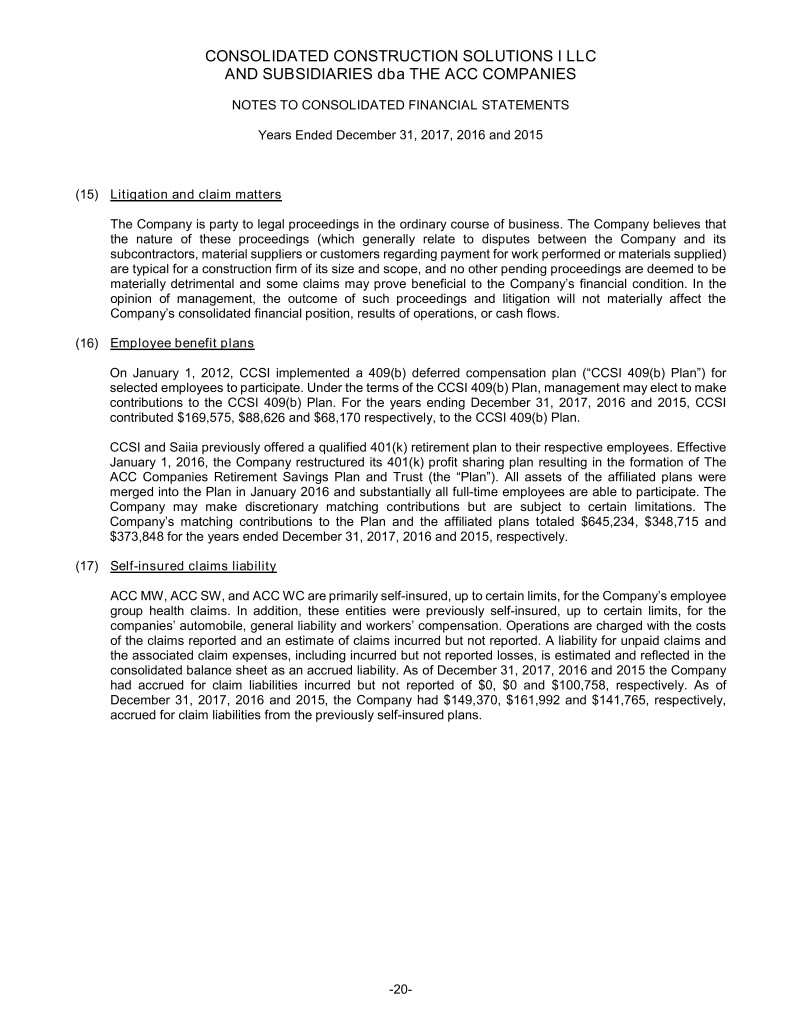
CONSOLIDATED CONSTRUCTION SOLUTIONS I LLC AND SUBSIDIARIES dba THE ACC COMPANIES NOTES TO CONSOLIDATED FINANCIAL STATEMENTS Years Ended December 31, 2017, 2016 and 2015 (15) Litigation and claim matters The Company is party to legal proceedings in the ordinary course of business. The Company believes that the nature of these proceedings (which generally relate to disputes between the Company and its subcontractors, material suppliers or customers regarding payment for work performed or materials supplied) are typical for a construction firm of its size and scope, and no other pending proceedings are deemed to be materially detrimental and some claims may prove beneficial to the Company’s financial condition. In the opinion of management, the outcome of such proceedings and litigation will not materially affect the Company’s consolidated financial position, results of operations, or cash flows. (16) Employee benefit plans On January 1, 2012, CCSI implemented a 409(b) deferred compensation plan (“CCSI 409(b) Plan”) for selected employees to participate. Under the terms of the CCSI 409(b) Plan, management may elect to make contributions to the CCSI 409(b) Plan. For the years ending December 31, 2017, 2016 and 2015, CCSI contributed $169,575, $88,626 and $68,170 respectively, to the CCSI 409(b) Plan. CCSI and Saiia previously offered a qualified 401(k) retirement plan to their respective employees. Effective January 1, 2016, the Company restructured its 401(k) profit sharing plan resulting in the formation of The ACC Companies Retirement Savings Plan and Trust (the “Plan”). All assets of the affiliated plans were merged into the Plan in January 2016 and substantially all full-time employees are able to participate. The Company may make discretionary matching contributions but are subject to certain limitations. The Company’s matching contributions to the Plan and the affiliated plans totaled $645,234, $348,715 and $373,848 for the years ended December 31, 2017, 2016 and 2015, respectively. (17) Self-insured claims liability ACC MW, ACC SW, and ACC WC are primarily self-insured, up to certain limits, for the Company’s employee group health claims. In addition, these entities were previously self-insured, up to certain limits, for the companies’ automobile, general liability and workers’ compensation. Operations are charged with the costs of the claims reported and an estimate of claims incurred but not reported. A liability for unpaid claims and the associated claim expenses, including incurred but not reported losses, is estimated and reflected in the consolidated balance sheet as an accrued liability. As of December 31, 2017, 2016 and 2015 the Company had accrued for claim liabilities incurred but not reported of $0, $0 and $100,758, respectively. As of December 31, 2017, 2016 and 2015, the Company had $149,370, $161,992 and $141,765, respectively, accrued for claim liabilities from the previously self-insured plans. -20-
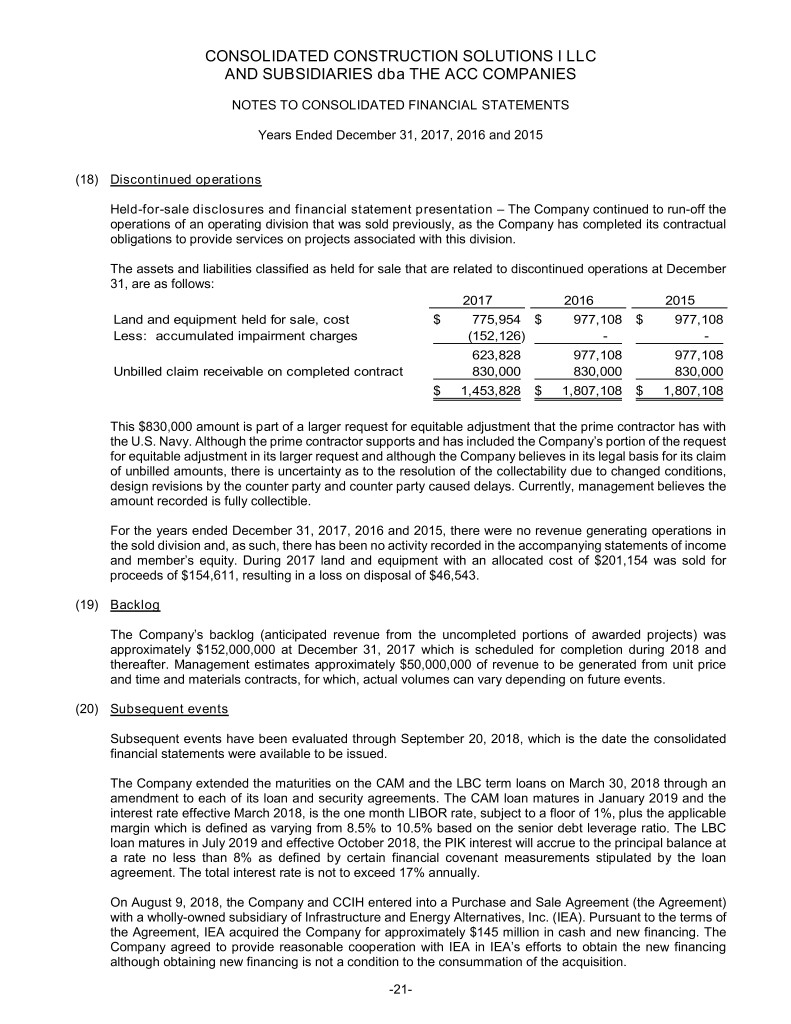
CONSOLIDATED CONSTRUCTION SOLUTIONS I LLC AND SUBSIDIARIES dba THE ACC COMPANIES NOTES TO CONSOLIDATED FINANCIAL STATEMENTS Years Ended December 31, 2017, 2016 and 2015 (18) Discontinued operations Held-for-sale disclosures and financial statement presentation – The Company continued to run-off the operations of an operating division that was sold previously, as the Company has completed its contractual obligations to provide services on projects associated with this division. The assets and liabilities classified as held for sale that are related to discontinued operations at December 31, are as follows: 2017 2016 2015 Land and equipment held for sale, cost $ 775,954 $ 977,108 $ 977,108 Less: accumulated impairment charges (152,126) - - 623,828 977,108 977,108 Unbilled claim receivable on completed contract 830,000 830,000 830,000 $ 1,453,828 $ 1,807,108 $ 1,807,108 This $830,000 amount is part of a larger request for equitable adjustment that the prime contractor has with the U.S. Navy. Although the prime contractor supports and has included the Company’s portion of the request for equitable adjustment in its larger request and although the Company believes in its legal basis for its claim of unbilled amounts, there is uncertainty as to the resolution of the collectability due to changed conditions, design revisions by the counter party and counter party caused delays. Currently, management believes the amount recorded is fully collectible. For the years ended December 31, 2017, 2016 and 2015, there were no revenue generating operations in the sold division and, as such, there has been no activity recorded in the accompanying statements of income and member’s equity. During 2017 land and equipment with an allocated cost of $201,154 was sold for proceeds of $154,611, resulting in a loss on disposal of $46,543. (19) Backlog The Company’s backlog (anticipated revenue from the uncompleted portions of awarded projects) was approximately $152,000,000 at December 31, 2017 which is scheduled for completion during 2018 and thereafter. Management estimates approximately $50,000,000 of revenue to be generated from unit price and time and materials contracts, for which, actual volumes can vary depending on future events. (20) Subsequent events Subsequent events have been evaluated through September 20, 2018, which is the date the consolidated financial statements were available to be issued. The Company extended the maturities on the CAM and the LBC term loans on March 30, 2018 through an amendment to each of its loan and security agreements. The CAM loan matures in January 2019 and the interest rate effective March 2018, is the one month LIBOR rate, subject to a floor of 1%, plus the applicable margin which is defined as varying from 8.5% to 10.5% based on the senior debt leverage ratio. The LBC loan matures in July 2019 and effective October 2018, the PIK interest will accrue to the principal balance at a rate no less than 8% as defined by certain financial covenant measurements stipulated by the loan agreement. The total interest rate is not to exceed 17% annually. On August 9, 2018, the Company and CCIH entered into a Purchase and Sale Agreement (the Agreement) with a wholly-owned subsidiary of Infrastructure and Energy Alternatives, Inc. (IEA). Pursuant to the terms of the Agreement, IEA acquired the Company for approximately $145 million in cash and new financing. The Company agreed to provide reasonable cooperation with IEA in IEA’s efforts to obtain the new financing although obtaining new financing is not a condition to the consummation of the acquisition. -21-






















